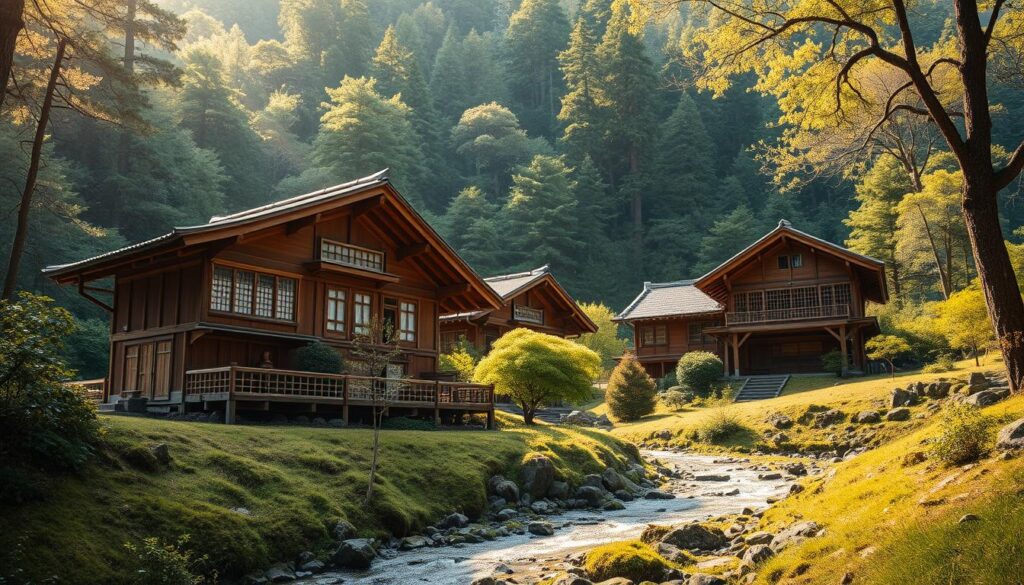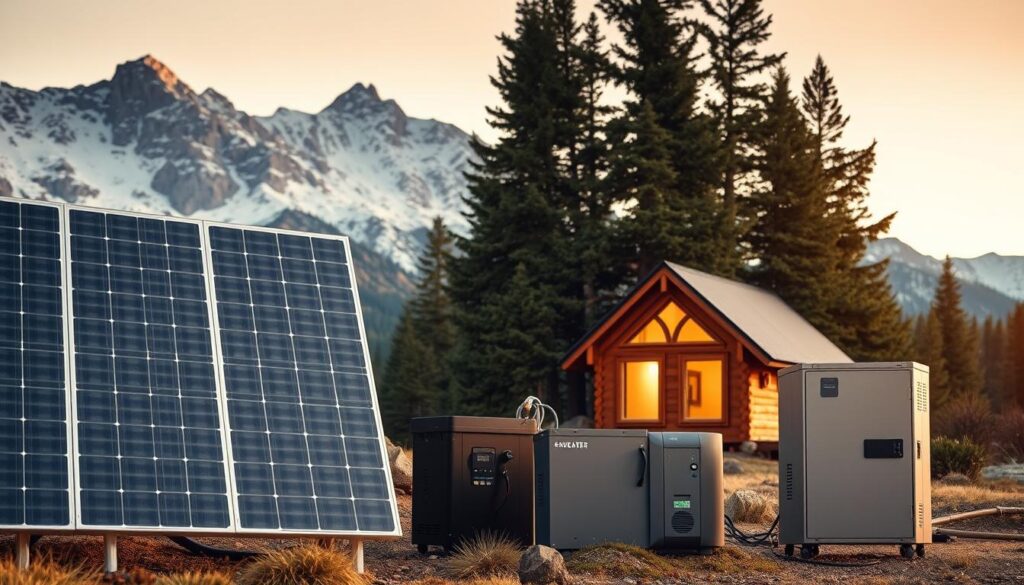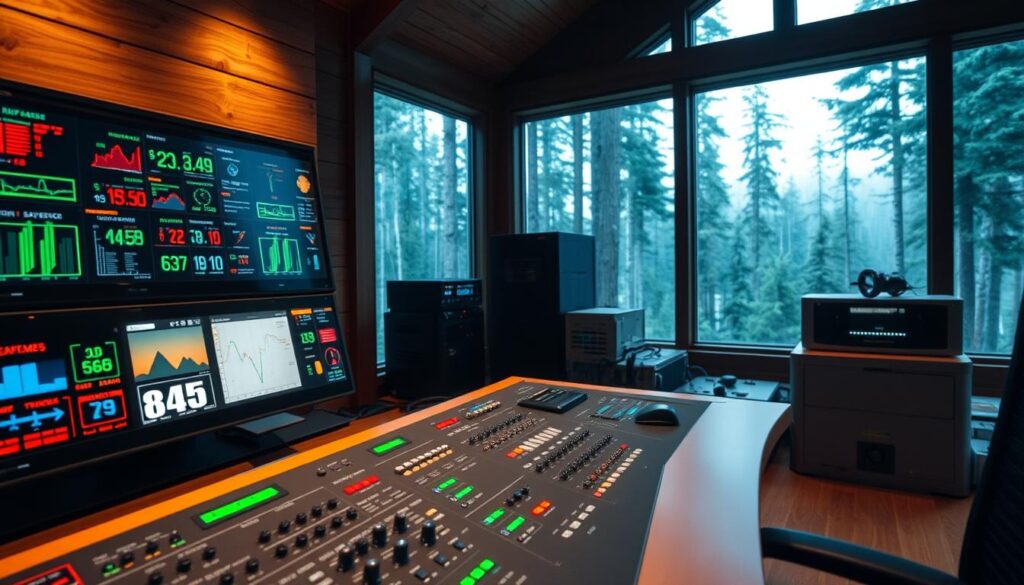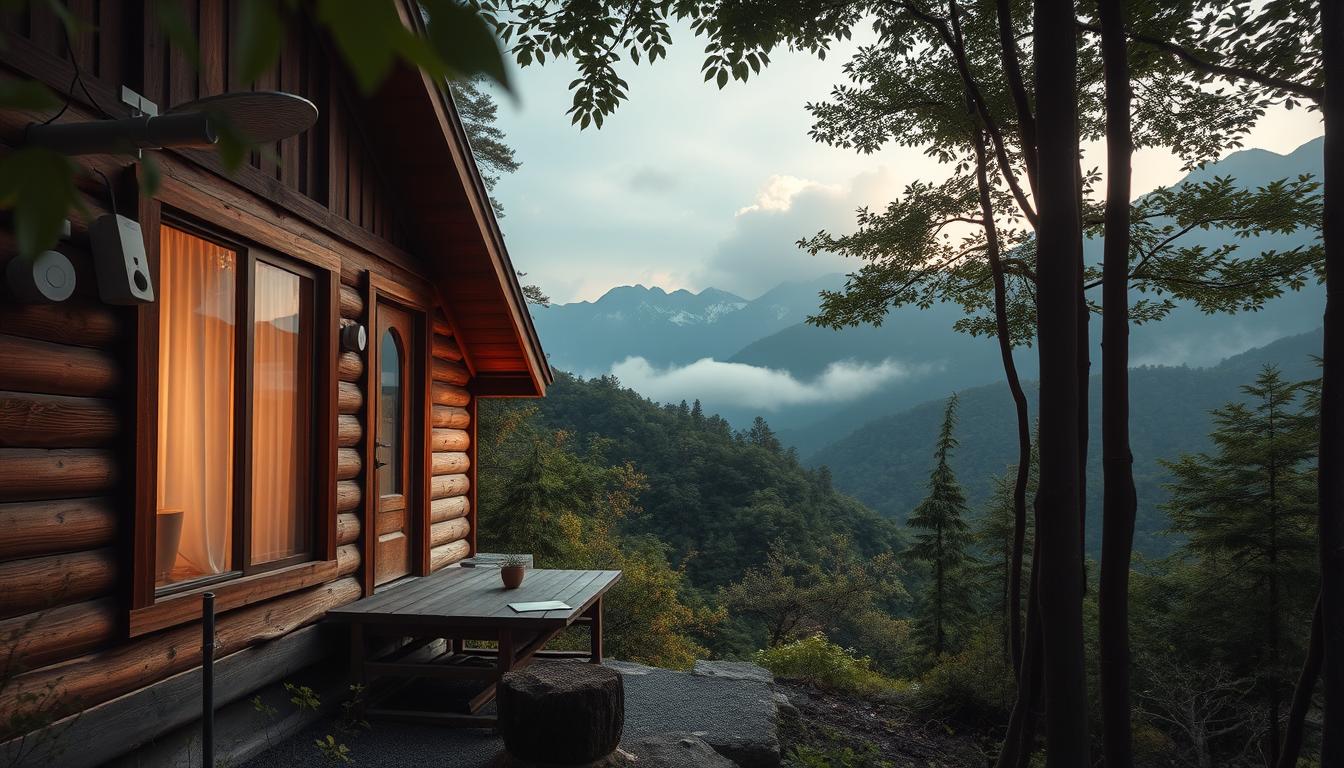Nestled deep in the mountains of Japan, Iya Valley is known for its traditional wooden cabins. Maintaining a comfortable environment within these isolated structures can be challenging. This is where climate sensors and automated cooling systems come into play, ensuring a cozy atmosphere without the need for constant manual adjustments.
The integration of smart climate control technology in these isolated wooden cabins is revolutionizing the way we experience traditional Japanese architecture. By leveraging climate sensors and automated cooling, these cabins can now maintain optimal temperatures, enhancing the overall comfort and sustainability of these unique dwellings.
Key Takeaways
- Efficient temperature management is crucial for comfort in isolated wooden cabins.
- Climate sensors play a vital role in monitoring and adjusting the environment.
- Automated cooling systems reduce the need for manual intervention.
- Smart climate control enhances the sustainability of traditional wooden cabins.
- Iya Valley’s traditional cabins are benefiting from modern climate control technologies.
The Unique Climate Challenges of Iya Valley
Iya Valley, nestled deep in the Japanese mountains, faces a distinct set of climate challenges that require specialized solutions. The valley’s remote location and unique geography contribute to its harsh weather conditions.
Geographical and Weather Patterns of Iya Valley
Iya Valley is characterized by its deep mountainous terrain, which significantly influences its weather patterns. The region experiences a continental climate with significant seasonal variations. “The valley’s geography creates a microclimate that is quite different from the surrounding areas,” as noted by local climatologists.
Seasonal Temperature Fluctuations in Deep Mountain Zones
The temperature in Iya Valley fluctuates greatly between seasons. Winters are harsh and cold, while summers can be mild. This fluctuation poses a significant challenge for maintaining a stable indoor climate in traditional wooden cabins.
Humidity and Precipitation Considerations
Iya Valley experiences high levels of humidity and precipitation throughout the year. The region’s high humidity can lead to moisture-related issues in wooden structures if not properly managed. Effective climate control systems must address these factors to preserve the integrity of the cabins.
By understanding these climate challenges, it’s possible to develop effective solutions for maintaining comfortable and sustainable living conditions in Iya Valley’s isolated cabins.
Traditional Wooden Cabins: Architectural Considerations

Iya Valley’s traditional wooden cabins are a testament to Japan’s rich cultural heritage. These structures, built using time-honored techniques, not only reflect the region’s history but also its adaptation to the local climate.
The architectural considerations of these cabins are multifaceted, involving historical construction methods, the thermal properties of wood, and ventilation techniques.
Historical Construction Methods of Iya Valley Cabins
The cabins in Iya Valley have been constructed using traditional methods passed down through generations. The use of local materials, such as cedar and cypress wood, has been prevalent due to their durability and resistance to decay.
Traditional Construction Techniques include mortise and tenon joinery, which provides structural integrity without the use of nails. This method allows for flexibility and resilience against natural disasters like earthquakes.
Thermal Properties of Traditional Japanese Wood Structures
Wood, as a natural material, has excellent thermal properties. It provides insulation against cold temperatures and can keep interiors cool during the summer.
The thermal mass of wood helps regulate indoor temperatures, reducing the need for modern heating and cooling systems. This natural regulation is crucial in Iya Valley, where temperatures can fluctuate significantly between seasons.
Ventilation in Traditional Design
Ventilation is a critical aspect of traditional Japanese architecture. The design of these cabins incorporates various ventilation techniques to ensure airflow and maintain indoor air quality.
Features such as tsuitae (sliding doors) and shoji screens allow for controlled ventilation, enabling the cabins to stay fresh and comfortable without relying on modern air conditioning systems.
| Architectural Feature | Function | Benefit |
|---|---|---|
| Mortise and Tenon Joinery | Structural Integrity | Resilience against earthquakes |
| Wooden Walls | Thermal Insulation | Regulates indoor temperature |
| Tsuitae (Sliding Doors) | Controlled Ventilation | Improves indoor air quality |
Smart Climate Control in Deep Mountain Zones: An Overview
Deep mountain zones pose distinct climate control challenges that can be effectively addressed through the adoption of smart technologies. These regions, characterized by their remote locations and unique environmental conditions, require innovative solutions to manage temperature, humidity, and air quality effectively.
Evolution of Climate Technology
The evolution of climate technology for remote locations has been significant. Initially, climate control in such areas relied on basic, manual systems that were often inefficient and labor-intensive. The advent of automated systems has transformed this landscape, enabling more precise control over environmental conditions. Modern climate technology integrates sensors, automation, and data analysis to provide optimal indoor climates, even in the most isolated locations.
Key advancements include:
- Improved sensor accuracy for temperature and humidity monitoring
- Automated control systems that adjust settings based on real-time data
- Integration with weather forecasting to preemptively adjust climate control settings
Benefits of Automated Systems
Automated climate control systems offer numerous benefits in isolated environments. They enhance comfort by maintaining optimal indoor conditions, reduce energy consumption through efficient operation, and minimize the need for manual intervention. This is particularly valuable in deep mountain zones where access can be limited.
“The use of automated climate control systems in remote areas not only improves living conditions but also contributes to the preservation of historical structures by maintaining a stable environment.” – Expert in Climate Control
Challenges in Historical Structures
Implementing smart climate control in protected historical structures presents unique challenges. These buildings often have architectural features that are sensitive to modern alterations, requiring climate control solutions to be discreetly integrated. Moreover, preserving the historical integrity while introducing modern technology demands a careful balance.
| Challenge | Solution |
|---|---|
| Preserving historical integrity | Discreet installation of climate control systems |
| Minimizing structural modifications | Using non-invasive technologies |
| Maintaining energy efficiency | Optimizing system design for historical building layouts |
Essential Climate Sensors for Mountain Cabin Environments
Advanced climate sensors are essential for monitoring and controlling the climate in mountain cabins. These sensors enable homeowners to maintain a comfortable and sustainable environment, even in remote locations. The right climate sensors can make a significant difference in the overall livability and energy efficiency of mountain cabins.
Temperature and Humidity Monitoring Solutions
Temperature and humidity monitoring are critical components of climate control in mountain cabins. Accurate sensors can detect even slight changes in temperature and humidity, allowing for precise adjustments to maintain optimal conditions. For instance, a temperature sensor can trigger the heating or cooling system to activate when the temperature deviates from the set range.
As noted by climate control experts, “the key to efficient climate control lies in the ability to monitor and respond to environmental changes in real-time.” This is particularly important in mountainous regions where weather conditions can fluctuate rapidly.
Air Quality and Ventilation Sensors
Air quality and ventilation sensors are equally important for maintaining a healthy indoor environment. These sensors monitor the levels of various gases and pollutants, ensuring that the air remains fresh and clean. Ventilation systems can be automated to exchange stale air for fresh air from outside, improving overall air quality.
Weather Prediction Integration for Proactive Climate Control
Integrating weather prediction technology with climate sensors allows for proactive climate control. By anticipating weather changes, the system can make adjustments in advance, ensuring that the cabin remains comfortable and energy-efficient. This forward-thinking approach can significantly reduce energy consumption and enhance the overall living experience.
Selecting the Right Automated Cooling Systems
In the context of isolated wooden cabins, selecting an efficient automated cooling system is vital for year-round comfort. The unique challenges of remote locations demand systems that are not only effective but also energy-efficient and adaptable to seasonal variations.
Energy-Efficient Cooling Technologies for Remote Cabins
Energy-efficient cooling technologies are crucial for minimizing the carbon footprint of isolated cabins while maintaining a comfortable indoor climate. Technologies such as inverter-driven air conditioners and evaporative cooling systems offer significant advantages in terms of energy savings.
Balancing Modern Technology with Traditional Aesthetics
One of the key challenges in implementing automated cooling systems in traditional wooden cabins is preserving their aesthetic integrity. It’s essential to select systems that can be discreetly integrated into the existing architecture, ensuring that the traditional beauty of the cabins is not compromised.
Adapting Systems for Seasonal Requirements
The ability to adapt cooling systems to seasonal requirements is vital for maintaining comfort throughout the year. This involves not just cooling in the summer, but also potentially providing heating in the colder months. Systems with reversing cycle capabilities or those that can be supplemented with heating elements are particularly valuable.
| Season | Cooling/Heating Needs | System Adaptations |
|---|---|---|
| Summer | High cooling demand | Increased cooling capacity |
| Winter | Heating demand | Reversing cycle or supplementary heating |
| Spring/Autumn | Mild temperatures | Energy-saving modes |
Power Solutions for Smart Systems in Off-Grid Locations

Implementing smart climate control systems in off-grid locations requires reliable and sustainable power solutions. In remote areas like Iya Valley, Japan, where traditional wooden cabins are nestled deep within mountains, the challenge lies in providing a consistent and efficient power supply.
Solar Integration for Climate Control Systems
Solar integration offers a viable solution for powering climate control systems in off-grid locations. By harnessing solar energy, these systems can operate efficiently without relying on traditional grid power. Solar panels can be installed in a way that complements the traditional architecture of the cabins, ensuring that the aesthetic integrity is maintained.
Battery Storage and Power Management
Battery storage is crucial for managing the power generated by solar panels. It ensures that the climate control systems continue to operate during periods of low sunlight or at night. Effective power management systems are necessary to optimize the use of stored energy, ensuring that the systems run smoothly and efficiently.
Backup Power Systems for Reliability
While solar power and battery storage provide a reliable source of energy, backup power systems are essential for ensuring continuous operation during extended periods of adverse weather. These systems can be designed to automatically kick in when the primary power source is compromised, thereby maintaining the comfort and safety within the cabins.
In conclusion, a combination of solar integration, battery storage, and backup power systems provides a comprehensive power solution for smart climate control systems in off-grid locations. This approach not only ensures reliability but also supports sustainability, aligning with the environmental ethos of regions like Iya Valley.
Installation Challenges and Solutions
Historical cabins in remote locations present distinct installation challenges that necessitate innovative solutions and local expertise. The integration of climate control systems in these traditional structures requires a delicate balance between preserving historical integrity and incorporating modern technology.
Working with Local Craftsmen and Modern Technicians
Collaboration between local craftsmen and modern technicians is crucial for successful installations. Local craftsmen bring invaluable knowledge of traditional construction methods, while modern technicians provide expertise in climate control technology. This synergy ensures that installations are both effective and sensitive to the historical context.
Weatherproofing Technology in Extreme Mountain Conditions
Weatherproofing is a critical consideration in the harsh mountain environment of Iya Valley. Technologies such as sealed enclosures and protective coatings can safeguard equipment against extreme weather conditions, ensuring reliability and longevity.
Minimizing Structural Modifications to Historical Buildings
To preserve the historical integrity of cabins, it’s essential to minimize structural modifications. This can be achieved through careful planning and the use of non-invasive installation techniques, ensuring that the climate control systems complement the traditional architecture without altering it.
Remote Monitoring and Control Systems

The integration of remote monitoring and control systems in isolated wooden cabins in Iya Valley, Japan, marks a significant advancement in maintaining optimal climate conditions. These systems enable homeowners to monitor and adjust the climate control measures remotely, ensuring a comfortable and sustainable environment.
One of the key components of these systems is wireless connectivity, which allows for seamless communication between the cabin’s climate control systems and the remote monitoring interface.
Wireless Connectivity Solutions for Deep Mountain Areas
Wireless connectivity solutions are crucial in deep mountain areas where traditional wired connections may not be feasible. Technologies such as satellite internet, cellular networks, or specialized wireless protocols enable reliable connectivity even in remote locations.
Benefits of Wireless Connectivity:
- Reliable data transmission
- Flexibility in system design
- Easy installation and maintenance
Smartphone Applications and User Interfaces
Smartphone applications play a vital role in remote monitoring and control, providing users with an intuitive interface to manage their cabin’s climate. These applications allow users to monitor temperature, humidity, and air quality in real-time and make adjustments as needed.
| Feature | Description | Benefit |
|---|---|---|
| Real-time Monitoring | Monitor climate conditions in real-time | Immediate response to changes |
| Remote Adjustments | Adjust climate control settings remotely | Enhanced convenience and comfort |
| Alerts and Notifications | Receive alerts for significant climate changes | Proactive maintenance and peace of mind |
Automated Responses to Environmental Changes
Automated responses to environmental changes are a critical feature of advanced climate control systems. By integrating sensors and predictive algorithms, these systems can automatically adjust climate control measures in response to changes in temperature, humidity, or other environmental factors.
By leveraging remote monitoring and control systems, homeowners in Iya Valley can ensure that their traditional wooden cabins remain comfortable and sustainable, even in the challenging deep mountain climate.
Preserving Traditional Aesthetics While Implementing Modern Technology
Integrating modern climate control technology into traditional Japanese cabins requires a delicate balance between preserving historical aesthetics and embracing innovation. The unique architectural style of Iya Valley’s wooden cabins is a significant part of Japan’s cultural heritage, and maintaining their traditional look is crucial.
Concealed Installation Techniques
One of the key strategies in preserving traditional aesthetics is using concealed installation techniques. This involves hiding modern technology such as sensors and cooling systems within the existing structure of the cabin. For instance, sensors can be discreetly placed behind traditional wooden panels or integrated into the cabin’s furniture.
Designing Complementary Systems
Designing climate control systems that complement the traditional Japanese mountain architecture is another important aspect. This can be achieved by selecting materials and designs that are in harmony with the cabin’s original construction. For example, modern components can be encased in materials that match the traditional woodwork, ensuring a seamless integration.
Using Traditional Materials to House Modern Technology
Utilizing traditional materials to house modern technology is a creative way to maintain the visual integrity of the cabins. For example, wooden boxes or traditional Japanese lacquerware can be used to conceal modern devices, blending them with the cabin’s décor. This approach not only preserves the aesthetic but also adds a layer of cultural continuity.
By adopting these strategies, it’s possible to enhance the comfort and sustainability of traditional Japanese cabins without compromising their historical charm. The successful integration of modern technology and traditional aesthetics in Iya Valley’s cabins serves as a model for preserving cultural heritage in other similar contexts.
Case Studies: Successful Climate Control Implementations
Successful climate control implementations in eco-tourism facilities and private residences in Iya Valley serve as models for balancing tradition with modern comfort. These case studies demonstrate how modern technology can be integrated into traditional settings without compromising their historical integrity.
The Thatched Roof Cabin Renovation Project
The renovation of a traditional thatched roof cabin in Iya Valley involved the installation of a sophisticated climate control system. This project required careful planning to ensure that the modern technology did not alter the cabin’s traditional aesthetic. The result was a significant improvement in indoor comfort without compromising the cabin’s historical integrity.
Eco-Tourism Facilities in Western Iya Valley
Eco-tourism facilities in western Iya Valley have benefited from the implementation of automated cooling systems. These systems have enhanced the visitor experience by providing comfortable living conditions while maintaining the natural surroundings. The use of solar-powered energy solutions has further contributed to the sustainability of these facilities.
Private Residences Balancing Tradition and Comfort
Private residences in the region have also seen successful implementations of climate control systems. Homeowners have been able to enjoy modern comforts while preserving the traditional architecture of their homes. The key to these successful implementations has been the careful selection of technology that complements the existing structures.
Environmental Impact and Sustainability Considerations
As we adopt advanced climate control technologies, it’s essential to consider their ecological footprint. The integration of smart climate control systems in isolated wooden cabins of Iya Valley, Japan, presents both opportunities and challenges in terms of environmental sustainability.
Minimizing Carbon Footprint
Reducing carbon footprint through smart climate control is a critical aspect of sustainable development. By optimizing energy consumption and utilizing renewable energy sources, such as solar power, these systems can significantly decrease reliance on fossil fuels. This not only contributes to a reduction in greenhouse gas emissions but also helps in maintaining the natural beauty and ecological balance of the region.
Preserving Natural Surroundings
Preserving the natural surroundings during the installation of climate control systems is equally important. This involves careful planning and execution to minimize the visual and physical impact on the environment. Techniques such as concealed installation and the use of traditional materials to house modern technology can help in blending the new systems with the existing architecture.
Long-term Environmental Benefits
The long-term environmental benefits of efficient climate control systems are multifaceted. They include not only the reduction in energy consumption and carbon emissions but also the preservation of the buildings themselves. By maintaining a stable and optimal indoor climate, these systems can help in preserving the structural integrity of traditional wooden cabins, thereby extending their lifespan and reducing the need for repairs or replacements.
In conclusion, the implementation of smart climate control systems in isolated wooden cabins must be approached with a keen eye on environmental sustainability. By minimizing carbon footprint, preserving natural surroundings, and ensuring long-term environmental benefits, we can achieve a harmonious balance between modern technology and traditional architecture.
Conclusion: Balancing Tradition and Technology in Japan’s Mountain Retreats
Implementing smart climate control in isolated wooden cabins in Iya Valley, Japan, requires a delicate balance between preserving traditional architecture and embracing modern technology. The unique climate challenges of this region demand innovative solutions that enhance comfort and sustainability without compromising the historical integrity of these structures.
By integrating climate sensors and automated cooling systems, it’s possible to maintain a comfortable environment within these cabins while minimizing their environmental impact. This approach not only preserves the natural surroundings but also ensures the long-term sustainability of these mountain retreats.
The key to successful implementation lies in balancing tradition with technology. This involves careful consideration of the architectural nuances of traditional Japanese wooden cabins and the incorporation of modern climate control solutions that complement their design. By achieving this balance, it’s possible to create comfortable, sustainable, and historically sensitive accommodations in Japan’s mountain retreats.
FAQ
What are the benefits of using climate sensors in isolated wooden cabins?
Climate sensors help monitor temperature, humidity, and air quality, ensuring a comfortable environment and preventing damage to the cabin’s structure.
How do automated cooling systems work in remote locations?
Automated cooling systems use sensors and weather forecasts to adjust cooling levels, providing a comfortable environment while minimizing energy consumption.
Can modern climate control systems be integrated into historical structures without compromising their integrity?
Yes, with careful planning and installation, modern climate control systems can be integrated into historical structures while preserving their traditional aesthetics.
What are the challenges of implementing climate control systems in protected historical structures?
Challenges include minimizing structural modifications, preserving traditional materials, and ensuring that modern technology does not compromise the historical integrity of the building.
How can solar integration and battery storage support climate control systems in off-grid locations?
Solar integration and battery storage provide a reliable and renewable energy source, enabling climate control systems to operate effectively in remote areas.
What are the key considerations for selecting the right automated cooling systems for isolated cabins?
Key considerations include energy efficiency, adaptability to seasonal requirements, and balancing modern technology with traditional aesthetics.
How can remote monitoring and control systems enhance the efficiency of climate control?
Remote monitoring and control systems enable real-time adjustments, automated responses to environmental changes, and convenient management of climate control systems.
What are the environmental benefits of using smart climate control systems in mountain cabins?
Smart climate control systems reduce carbon footprint, preserve natural surroundings, and provide long-term environmental benefits through efficient energy use.
How can traditional materials be used to house modern climate control technology?
Traditional materials can be used to create enclosures or conceal modern technology, preserving the visual integrity of traditional cabins.
What are some successful examples of climate control implementations in traditional Japanese cabins?
Examples include the Thatched Roof Cabin Renovation Project, eco-tourism facilities in Western Iya Valley, and private residences that balance tradition and comfort.
